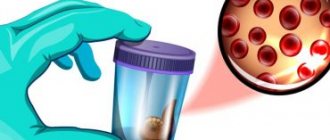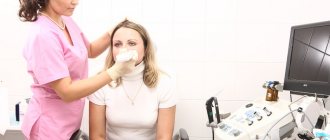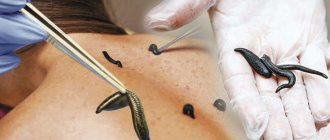Causes of bleeding from the anus
If you notice blood on toilet paper after bowel movements, even if the process of bowel movement occurs without pain, you should definitely consult a proctologist for advice in order to establish the cause of the bleeding, start treatment in a timely manner and avoid possible complications.
Why does blood appear from the anus after stool in both men and women:
- A fairly common factor is hemorrhoids (enlargement of the veins of the rectum). Scarlet blood appears from the anus during defecation.
- Anal fissure is the second most common cause of rectal bleeding. The disease is characterized by a burning sensation during bowel movements, sometimes accompanied by acute pain (patients describe it as cutting and then squeezing). Bloody discharge appears in both small and copious portions.
- Inflammatory diseases of the colon.
- The presence of benign formations (polyps). A characteristic symptom is the discharge of blood from the rectum after defecation. The blood is darker, often with mucus.
- The presence of a malignant tumor of the rectum. Blood of different colors may be released. Quite often, the blood released does not differ in any way from the blood that is released, for example, from hemorrhoidal tissue. And if the presence of hemorrhoidal disease only worsens the quality of life (hemorrhoidal tissue never degenerates into a malignant tumor), then the presence of a benign formation or a malignant tumor can be harmful to health and life-threatening, which is why you should not try to independently determine the source.
Only a coloproctologist can determine the true cause of bleeding from the anus and select the appropriate treatment. Timely diagnosis allows for effective conservative and minimally invasive treatment.
Discharge color and disease
- bright red, scarlet blood from the anus on toilet paper or underwear, drops at the end of a bowel movement (stool) - hemorrhoids or anal fissure;
- red color of blood during anal bleeding - cancerous tumor, intestinal polyp;
- dark blood clots - tumors of the distal colon, diverticulosis;
- cherry-colored blood from the anus - pathology of the colon;
- black, tarry stools - diseases of the stomach, duodenum and small intestine.
IMPORTANT!
Bleeding is a serious symptom, after the appearance of which you cannot postpone a visit to the doctor. Unfortunately, blood from the anus can cause diseases such as a tumor of the rectum or colon. And in the worst case, this tumor may turn out to be malignant. Blood can also occur as a result of injury to a polyp - a benign tumor. Long-term polyposis can be a sign of colon cancer.
Black stool is a sign of bleeding
It is important to consider that blood is not always visible in feces. If the source of bleeding is located in the upper gastrointestinal tract, then it loses its red color and becomes black. In such cases, they talk about occult blood in the stool .
Black feces and tar-black clots are characteristic of dangerous diseases:
- Bleeding from the veins of the esophagus.
- Stomach or duodenal ulcer.
- Erosive gastritis.
- Gastroesophageal reflux disease of the esophagus.
- Neoplasms of the esophagus.
- Intestinal tuberculosis.
- Colon cancer, benign tumors.
- Polyps.
- Cirrhosis of the liver.
The reason may also lie in problems with blood vessels and damage to the arteries of internal organs. In children, the presence of blood in the stool may indicate dysbacteriosis, intestinal obstruction, and allergic reactions.
You cannot examine the contents of the toilet on your own; it is a waste of time. Even a specialist will never make a diagnosis based solely on external signs and stool analysis.
Bleeding pattern and disease
- Regular heavy bleeding not associated with bowel movements - diverticulosis, polyposis, Crohn's disease, ulcerative colitis, rectal or colon cancer;
- Blood mixed with feces - cancer of the rectum and colon;
- Bleeding with diarrhea - dysbiosis, irritable bowel syndrome;
- Discharge of blood with mucus or pus - internal hemorrhoids, rectal prolapse or polyp;
- Severe bleeding with mucus - proctitis, colitis, rectal cancer.
Make an appointment
Crohn's disease
Crohn's disease is a severe inflammatory disease of all layers of the intestinal wall. In this case, nodules called granulomas appear inside the intestinal wall. The disease cannot be completely cured, only achieving remission. Crohn's disease affects all parts of the gastrointestinal tract. The mucous membrane becomes covered with ulcerative lesions, the ulcers can deepen, pseudopolyps are formed, polyps and ulcers alternate with each other. When the disease becomes more complicated, fever, bleeding, abscesses, fistulas, and peritonitis appear. Characterized by abdominal pain, flatulence, weight loss, anemia, hypovitaminosis. The disease develops slowly over several years. With Crohn's disease, symptoms such as damage to the joints, the mucous membrane of the eyes, and inflammation of the lymph nodes appear.
Diagnosis and treatment
When faced with an intimate problem, especially such as bleeding from the anus during bowel movements, you can get confused, especially if you don’t know about the methods of diagnosing and treating such ailments or don’t understand which doctor to contact.
A proctologist or coloproctologist is a doctor who diagnoses and treats diseases of the colon, rectum and anus, as well as problems of the sacrum, coccyx and perineum. You should not postpone a visit to this specialist if there is blood from the anus after stool.
A proctologist will listen to complaints and the history of their occurrence, and to determine the cause of the appearance of blood from the rectum, he may perform the following procedures:
Digital examination of the rectum: a primary research method that makes it possible to assess the condition of the anus and identify possible pathologies in the form of neoplasms, anal fissures, uncharacteristic discharge, and bleeding.
After a digital examination, the coloproctologist, if necessary, prescribes further diagnostic methods using special equipment:
- Anoscopy. This is an examination of the last 3-7 cm of the rectum; it is in this area that almost half of the sources of visible bleeding are located. There are several types of anoscopes (straight, conical, with and without a cutout, transparent and not transparent), each of them is used strictly according to indications, but any of these types allows you to perform a full examination of the anal canal and lower ampullary rectum. Anoscopy is used when performing minimally invasive methods of treating hemorrhoids (ligation, sclerotherapy), as well as performing a number of surgical interventions (bipolar coagulation). As a rule, no preparation is required to perform diagnostic anoscopy; preparation is required for anoscopy for therapeutic purposes.
- Sigmoidoscopy or rectoscopy (RRS or RRS) is a diagnostic procedure using a special device with a camera. It makes it possible at the initial appointment to quickly and painlessly visually assess the condition of the rectal mucosa, identify the presence of mucosal formations and compression of the intestine. During rectoscopy, up to 20 cm of the intestine is examined (the entire rectum and the place of its transition to the sigmoid). Preparation is required for rectoscopy.
- Colonoscopy is the most informative method of examining the large intestine compared to others. It is carried out using a flexible fiber colonoscope equipped with a high-resolution camera that will show even the smallest sources of bleeding. The procedure is also prescribed for the purpose of endoscopic removal of colon formations. A colonoscopy is performed by an endoscopist.
The appropriate method of treating the disease is determined and prescribed by the doctor. You should not engage in self-treatment and neglect contacting a coloproctologist.
What kind of help should there be?
The appearance of any variants of anal bleeding is subject to detailed analysis and diagnosis of the cause of its occurrence. This applies not only to acute cases of new bleeding, but also to those types of bleeding that have been observed in people for a long time. You can’t interpret everything as chronic hemorrhoids. After all, no one is immune from the occurrence of tumors. Rather, on the contrary, persons with chronic pathology of the rectum and anal canal, first of all, should be examined, since they constitute a risk group. In life, things don't happen quite like that. Only those who experience anal bleeding for the first time immediately seek help. Patients with chronic rectal bleeding do not always do this.
The main measure of assistance, regardless of its cause, should be a thorough diagnosis. This is, first of all, an examination of the rectum and colon. They include:
- Finger examination;
- Sigmoidoscopy (examination of the rectum and initial part of the sigmoid colon with a rigid device);
- Fibercolonoscopy (examination of the entire large intestine with a flexible endoscope);
- Irrigography – an X-ray examination of the large intestine by filling it with contrast followed by photographs;
- A clinical blood test is required to determine the level of hemoglobin, red blood cells and hematocrit number.
Treatment of anal bleeding is a relative matter. Indeed, if they occur as a symptom, it is necessary to diagnose the causative disease. Only by eliminating it can you get rid of the bleeding. The only exceptions are profuse bleeding with large blood loss, the treatment of which becomes an emergency measure. It could be like this:
- For bleeding hemorrhoids - venotonic tablets (venodiol, detralex, phlebodia, normoven), preferably in high single doses. Suppositories and ointments are required (procto-glivenol, ultraproct, proctosedyl, proctosan). Continued bleeding is an indication for packing the anal canal with gauze pads soaked in aminocaproic acid or hydrogen peroxide. If these measures do not help stop the bleeding, surgical treatment is indicated (stitching or removal of bleeding hemorrhoids);
- For disintegrating tumors, colon and rectal polyps with bleeding, infusion therapy with hemostatic drugs (etamsylate, vikasol, aminocaproic acid) is indicated. If there is no effect, attempts must be made to endoscopically stop the bleeding by identifying the source and cauterizing it. In extreme cases, surgical treatment is performed;
- Bleeding in inflammatory bowel diseases is very rarely active. Usually, they do not require specific measures to stop them. Treatment of the underlying disease leads to a reduction in anal bleeding.
A gentle regimen is indicated for all patients with this pathology. In case of massive profuse bleeding, it should be done in bed. The diet involves the exclusion of spicy foods, alcohol, smoked foods, and in case of severe bleeding, food is completely prohibited.
Anal bleeding is the tip of the iceberg of the disease. Don’t forget about this when dealing only with stopping it. Treating the cause is the only correct way to eliminate it.
How to prepare for the examination?
The own research of specialists from the proctology department of the Altermed clinic made it possible to make a visit to a proctologist as easy and comfortable as possible. There is no longer any need to fast the day before and plan the procedure for the morning. In the proctology departments of Altermed, a way has been found to successfully cope with all these difficulties. This is Microlax bowel preparation.
The use of Microlax microenemas makes fasting unnecessary, does not require special equipment or premises, and saves a lot of time. The laxative effect occurs 5-15 minutes after administration of the drug. The quality of bowel cleansing is such that treatment can begin immediately after rectoscopy and anoscopy. If it is necessary to use during pregnancy and lactation, Microlax does not require special precautions.
The Proctology Clinic provides diagnostics using the most modern equipment. The best doctors in St. Petersburg - both men and women - and a delicate approach are at your service.







